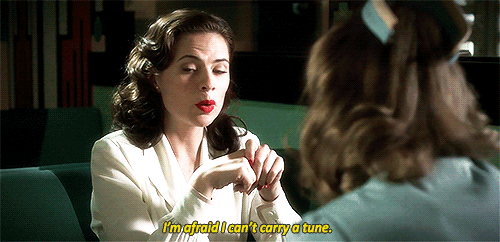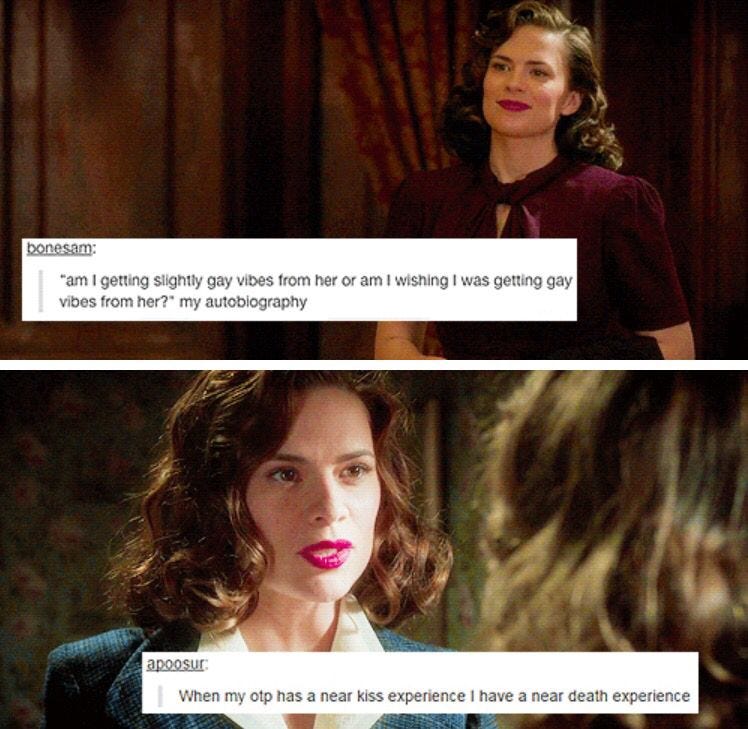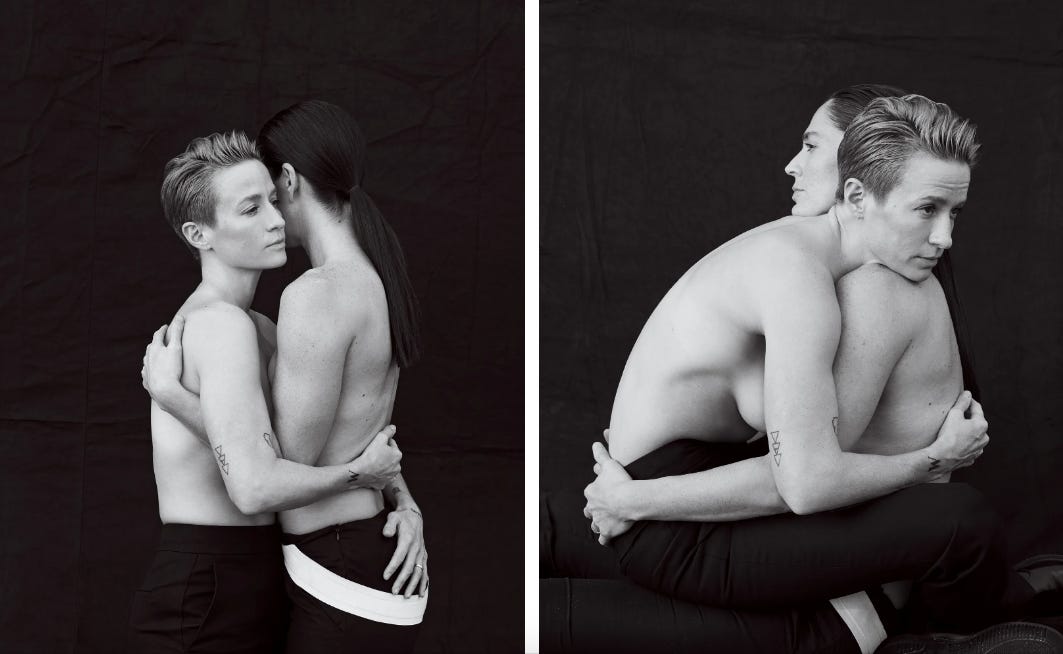Together, In Heaven and In Hell
On Happiness, Protracted
This is the Sunday edition of Paging Dr. Lesbian. Plus, this week’s dispatch from the lesbian internet. If you like this type of thing, subscribe!
The Price of Salt, first published in 1952, is often referred to as the first lesbian novel with a happy ending. This fact was one that resonated with readers then, and continues to do so now. The origin story of the book, however, is less well known. The Price of Salt was written by Patricia Highsmith, who also wrote a number of successful psychological thrillers (notably, her Tom Ripley series, as well as Strangers on a Train, which was turned into a Hitchcock film). Despite the renown of these other novels, and despite the fact that she originally published the novel under the pseudonym “Claire Morgan,” Highsmith continued to get letters about The Price of Salt for the rest of her life. The book surged in popularity once again after Todd Hayne’s adaptation of the book (entitled Carol) was released in 2015.
The novel’s moving introspection, as well as its notable happy ending, were clearly very meaningful to people. The “real” story of The Price of Salt was decidedly less cheerful. Therese’s job, and her first meeting with Carol, was taken directly from Highsmith’s own life. In December 1948, while working at the Bloomingdale’s toy counter to pay for her psychoanalysis (ostensibly to stamp out her own “latent homosexuality”), Highsmith sold a doll to a beautiful blonde woman in a mink coat. Though she never saw the woman again, her appearance must have sparked something in Highsmith, because that same night she wrote the entire outline for The Price of Salt. Several years earlier Highsmith had an affair with a wealthy divorcee named Virginia Kent Catherwood and she would become another inspiration for the character of Carol (Catherwood too lost custody of her daughter after her husband hired a detective to record her and a female lover).
While Carol and Therese’s story ends on a relatively positive note, the same cannot be said for these women. The woman Highsmith sold the doll to – a Mrs. E.R. Senn – was an alcoholic who committed suicide the year before the book was published. Highsmith’s former lover, Mrs. Catherwood, was also an alcoholic and died in 1966 at the age of 51. Another one of Highsmith’s lovers – an artist named Allela Cornell with whom Highsmith had an affair in 1943 – committed suicide in 1946 by drinking nitric acid. In regards to Highsmith’s own happiness (or lack thereof), perhaps her behavior was to blame – by many accounts, she was anti-Semitic and espoused racist views, and she was not known to treat her lovers with much consideration.
Regardless of the particular reasons for all of this unhappiness (though that is an important conversation to be had another day), it is evident that many lives during this period were riddled with tragedy. But despite Highsmith and her contemporaries’ perpetual struggle for a so-called “happy” life, Highsmith was able to imagine a positive ending for Carol and Therese, however muted it may have been. To give you a sense of how Highsmith tells the conclusion of their story, I will quote it here at length. Very similar to how it is shown in the film adaptation, the book ends with Therese visiting Carol at a restaurant where she is dining with friends.
Carol raised her hand slowly and brushed her hair back, once on either side, and Therese smiled because the gesture was Carol, and it was Carol she loved, and would always love. Oh, in a different way now, because she was a different person, and it was like meeting Carol all over again, but it was still Carol and no one else. It would be Carol in a thousand cities, a thousand houses, in foreign lands where they would go together, in heaven and in hell.
Just as in the film, the final page and final line of the book concludes with Therese finally locking eyes with Carol.
Therese waited. Then as she was about to go to her, Carol saw her, seemed to stare at her incredulously a moment while Therese watched the slow smile growing, before her arm lifted suddenly, her hand waved a quick, eager greeting that Therese had never seen before. Therese walked toward her.
In the world of romance novels, this resolution is considerably more subdued than one might expect for a book that is specifically known for its happy ending. Nonetheless, such a coda must have been a revelation for the many queer women who would have secretly sought out this book to read. The 1950s was the height of popularity for lesbian pulp novels, books that while they were voraciously consumed by queer women, often also contained derogatory messaging and basically never included happy endings. Though some of these books were actually written by lesbians themselves, such novels almost always ended in some type of confinement – a return to heterosexual marriage, death, or literal confinement in a mental institution. As such, the ending of this book (and its filmic counterpart) is one of the features that have made it such an enduring cultural object.

Certainly, we have come a long way since Highsmith first published The Price of Salt in 1952. In the 21st century, lesbian pulp novels are amusing relics of a bygone era and the internet provides ample opportunities for us to tell and seek out our own stories. Despite this, there is still a contemporary fascination and longing for these happy endings, fictions that were once an extreme rarity, if they existed at all.
I’ve written about this before, but some of this contemporary hunger for happy endings is also coupled with a particular attraction to lesbian period pieces, a trend that has become increasingly popular over the last few years. On the part of Hollywood, it seems this trend is a result of the belief that these films will be a safer risk financially (they are generally understood to be white, chaste, and less overtly “political,” though many filmmakers have also challenged these assumptions). For sapphic fans, however, there is a particular thrill in being able to finally find yourself in history.
The pairing of these two ideas – lesbian period pieces (or “vintage lesbians” as I call them) and happy endings – brings me to my next topic of consideration: Cartinelli. Cartinelli (a portmanteau of “Martinelli” and “Carter”) is a non-canonical (meaning not confirmed within the original media product) sapphic couple from the CBS series Agent Carter (2015-2016), which is itself a part of the broader Marvel universe. Curiously, considering its superhero origins, this couple actually makes an interesting companion to Therese and Carol’s, quiet, 1950s romance.
To give you some backstory – Agent Carter centers on Peggy Carter (played by Hayley Atwell), a former military agent during WWII (and former paramour of Captain America) as she works at a covert government organization in New York City in the year 1946. While there, she meets Angie Martinelli (Lyndsy Fonseca), a waitress at her favorite diner who becomes her only friend in the city. (For Cartinelli fans, of course, this relationship has romantic undertones). The series only ran for two seasons for a total of 18 meager episodes, with Angie only appearing in seven of them. From what I can gather from YouTube compilations of all their scenes, Angie and Peggy only had about 24 minutes of screentime together throughout the whole series (Fonseca was not a part of the show in Season Two). Despite these constraints, their relationship is wonderfully flirtatious and playful – Angie immediately gives Peggy a flirtatious nickname (“English,” because of her accent) upon meeting her, and in one memorable scene she comments on the appeal of Peggy’s legs – and culminates in them moving into a mansion together at the end of Season 1.
In spite of their fairly minimal screentime, their relationship (both what we saw on screen and whatever else was inferred) immediately captured fans, who christened the couple “Cartinelli.” Though the series itself was never as popular as other Marvel or DC shows – it was canceled after the second season – this small fandom quickly grew in size, even catching the attention of Atwell and Fonseca who have themselves voiced support for the relationship.

This is where fanfiction comes in. Because Cartinelli was never made canon (ie. their relationship was never confirmed or made “official” in the series itself) and in fact never had that much screen time to begin with, many fans were inspired to write their own version of the story to make up for this shortage. While some of these works are “AUs” (meaning they take place in an alternative universe) and are set in the modern-day, many take the setting and time period of the show as inspiration. Though the show itself has not been on air since 2016, there has been a small but noticeable revival in the fandom in recent months, mainly due to the aforementioned works written by these authors.

This brings me back, once again, to The Price of Salt. When Highsmith wrote The Price of Salt, she based it in part off of her own experiences while also imbuing it with her own dreams for a more hopeful future, dreams that her readers consumed with voracious attention. With Cartinelli, fans have taken this fictional couple (or non-couple, depending on how you look at it) and injected them with this same optimism, optimism that was clearly not shared by the show’s creators. Cartinelli also exemplifies the practice of reaching for happiness among unfavorable conditions – both within the Marvel cinematic/televisual universe, which is known for including very few queer characters, as well as in the ostensibly anti-queer setting of the 1940s.
Delightfully, (and perhaps unsurprisingly, depending on your knowledge of fanfiction writing), crossover fanfics that feature both Cartinelli and Therese and Carol actually exist. It may come as little surprise, given the themes I’ve already explored here, that writers of these fics overwhelmingly favor happy endings over sad ones, and these crossover fics are no exception. That is not to say, however, that hardships don’t exist for these characters. In fact, some of these fanfics involve extensive research on behalf of the writers, touching on 1940s-specific homophobia, the lesbian bar scene of the time (and the dangers therein), and how the two women might have navigated their relationship given the circumstances. (Violets, which were once used as a symbol of sapphic affection, are a common plot device).
These writings, though fantastical in their inspiration, often involve our titular heroines overcoming serious obstacles in order to achieve some sort of domestic bliss. (In some period-specific fics, the two women are actually able to have a child together due to the scientific machinations of playboy genius Howard Stark, father of Tony Stark, AKA Iron Man). These conclusions may seem banal or overly saccharine to the uninformed, but their simplicity belies a continued desire for such simple pleasures on behalf of sapphic fans. There is very obviously pleasure in finding these characters – who exist in a time period that we often dismiss because of its assumed rigidity – in happy, settled relationships where they finally feel at home. Indeed, that some writers have thought to have Peggy, Angie, Therese, and Carol meet and cavort in these universes indicates how much they have all become cultural touchstones for this period in time and what it could have looked like. (Or at least, what we wish it could have looked like).
So what does it mean that this intense desire for joyful conclusions, coupled with an eagerness to rework history, continues to persist? Certainly, some of this must be due to the fact that some people simply prefer happy endings to sad ones and that there will always be an appetite for period pieces, with their charmingly antiquated dialogue and dated social mores. But perhaps there is something unique about the combination of these two factors – that by placing one’s grandiose hopes and dreams for the future in a bygone era, they might carry more weight. Of course, the setting Highsmith placed her characters in was her own, but contemporary sapphics have continued to find themselves in her work, as evidenced by Therese and Carol’s ceremonious entry into the action-packed universe of Agent Carter.
Perhaps, it is more like what Judith Butler wrote in her 2004 book Undoing Gender, that “fantasy is a part of the articulation of the possible; it moves us beyond what is merely actual and present into a realm of possibility, the not-yet actualized or the not actualizable.” As we now know from her biography, Highsmith was not actually able to live out the life that Therese and Carol might have lived out at the end of The Price of Salt. But in writing her most influential novel (Hitchcock be damned), she articulated what had not yet been, but perhaps what could be, in another time. For Cartinelli fans, this hope stretches out not forward, but deep into the past (stretches out, perhaps, like a “perpetual sunrise,” as Carol writes to Therese in a letter). Regardless of the direction in which this sentiment flows, it is, like Butler says, expansive, in that it expands the very conditions of possibility. If #Cartinelli lives, (alongside Therese and Carol), then perhaps so does the (past)future happiness that they are able to miraculously inhabit. “Together, in heaven and in hell.”
Welcome to this week’s dispatch from the lesbian internet.
Last Saturday, noted bisexual and emo queen Phoebe Bridgers performed on Saturday Night Live. During her second song, the incredible “I Know The End” (which, by the way, ends in extended screams), she smashed her guitar to finish out the performance. For some reason (say: misogyny?), some people were very upset with her for doing this, even though guitar-smashing has been a mainstay of rock performances for like, ever. As always, Bridgers remained unphased by her haters and succinctly summarized the situation below.
As it has apparently become tradition, there is yet another JoJo Siwa update this week. On Monday, Siwa announced the identity of her girlfriend, who as it turns out is also her best friend of over a year. (Her girlfriend made a similar announcement). Siwa’s post also included photos of them wearing onesies at Disneyland (pictured below). To make matters even more adorable, she made this announcement on their one month (!!!) anniversary. So sweet, and so gay. Going to go vicariously live through their happiness now, bye!
In what was a monumental day for sports fans and sapphics everywhere, iconic Seattle sports couple Megan Rapinoe and Sue Bird were featured on the cover of GQ on Tuesday as a part of their “Modern Lovers” issue. In the accompanying interview, Rapinoe and Bird discuss how their relationship has improved both their lives and careers, their forays into activism, and their recent engagement. The article also features input from our other iconic sapphic sports couple, USWNT players Ashlyn Harris and Ali Krieger, and tennis icon Billie Jean King. Check it out!
In upsetting news, on Wednesday actor and star of Angel and Buffy Charisma Carpenter accused Buffy creator Joss Whedon of being abusive towards her during her time on both shows (but in particular on Angel). Much of this abuse coalesced around her pregnancy, which eventually led to her being fired from the show. (For more on this, read these great articles). Carpenter finally chose to speak about her experiences in particular in support of actor Ray Fisher, who last year claimed Whedon was abusive to him on the set of Justice League.
This news (which is not the first time Whedon’s questionable behavior has been brought up) is particularly upsetting for Buffy fans, who have long seen the show as an empowering object for women and queer people in particular. (Buffy character Tara is probably my favorite lesbian character of all time). Unfortunately, the “feminist” legacy of these shows has probably shielded him from such criticism in the past, as some Twitter users have pointed out. Several other actors have come out in support of Carpenter, including Amber Benson (who played Tara), Eliza Dushku (who has herself come forward with stories of an abusive set), and Clare Kramer (Glory). Sarah Michelle Gellar (Buffy) made a vague post on Instagram saying she is not making any further statements because she is “focusing on her family,” and Michelle Trachtenberg (who played Buffy’s younger sister, Dawn, and was 15 at the time of filming) responded to this by saying “we know what he did.” Lost in all of this hullabaloo about who said or knew what is the fact that so far none of the men from Buffy or Angel have come out in support of Carpenter, as noted by The Mary Sue.
As upsetting as this news is to Buffy fans, Whedon’s behavior must be taken into account when considering the legacy of the show and of the larger Whedonverse, at the same time as we honor the special place the show(s) holds in many of our lives. At the very least, I hope Whedon never gets to direct anything ever again.
In happier news, Taylor Swift has finally blessed us with a re-recorded track from the vault. After cartoon villain Scooter Braun bought (and sold) Swift’s masters in 2019, Swift vowed to re-record her entire pre-Universal catalog as a means to own all of her music (and to stop Braun from continuing to reap the profits from her life’s work). On Thursday morning, Swift made a surprise announcement that she was going to be re-releasing all of Fearless, plus six never-before-heard tracks, on April 9th, along with the “new” version of Love Story that night. (The date of the album release, of course, was hidden in a secret message on her Instagram post, which I spent way too long blearily trying to decode from my bed early that morning). The Swiftian renaissance continues.
That’s all for this week, folks! Stay tuned for next week’s exciting adventure. I will leave you with this image, which I found while doing my serious investigative work for this article.

Click for the full story.














